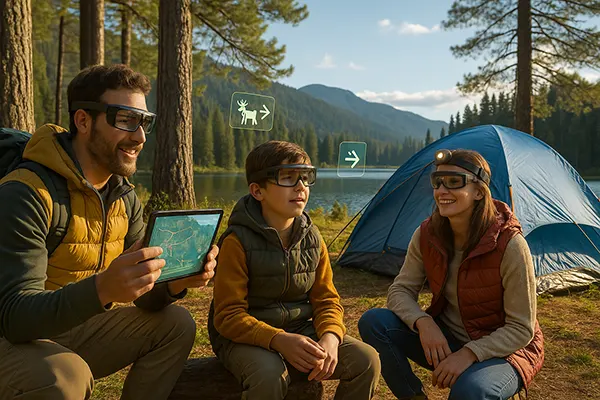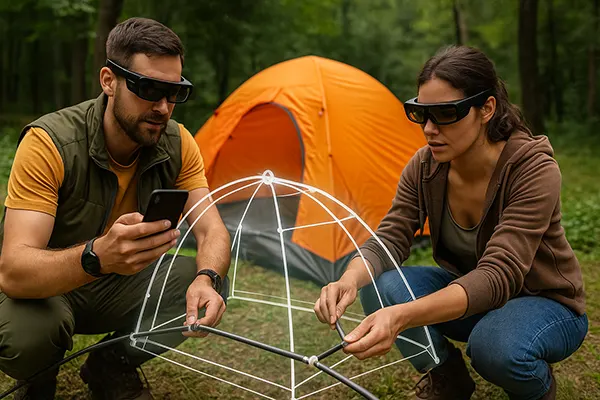
Augmented Reality Camping: How AR Technology is Reshaping Outdoor Travel
Camping has long been associated with unplugging from technology, reconnecting with nature, and enjoying simplicity. However, as the boundaries between the digital and physical worlds blur, augmented reality (AR) is quietly transforming the traditional camping experience. In 2025, AR is no longer just a gimmick—it has become a functional tool that enhances safety, entertainment, navigation, and education during outdoor adventures.
Navigation and Orientation: Smarter Hiking with AR
One of the key uses of augmented reality in camping today is real-time navigation. Applications like ViewRanger and PeakFinder enable users to superimpose trail maps and terrain details directly onto the natural landscape through smart glasses or mobile screens. Hikers can now see their path in augmented form, helping them avoid wrong turns and better estimate travel times.
In addition to route guidance, AR tools assist in identifying landmarks, plant species, and geological formations. Instead of flipping through guidebooks or maps, campers simply point their device at a mountain or tree to receive instant information. This innovation turns ordinary hikes into interactive learning experiences.
Emergency preparedness is another benefit. AR-powered alerts for sudden weather changes or hazardous conditions such as landslides or forest fires are sent in real time, improving response times and ensuring camper safety. This contextual awareness elevates wilderness exploration to a new standard of intelligence.
How AR Elevates On-Site Safety
Many AR-enabled devices now include overlays that warn of dangerous terrain, restricted wildlife zones, or natural hazards. For instance, AR can indicate which trails are temporarily closed or highlight unstable ground areas using colour-coded visuals visible through smart lenses. This prevents unnecessary risks and guides hikers along safer routes.
Additionally, AR-assisted geotagging enables groups to stay connected. If a member strays from the designated path, their location can be easily tracked using shared AR pins—particularly valuable for families with children or large expedition teams. In emergencies, rescue teams can also use this data to reach the exact coordinates of a lost camper faster than ever before.
Another growing trend in 2025 is the integration of AR into wearable first-aid tutorials. When an accident occurs, users can activate their AR app to receive interactive guidance on treating injuries, from CPR to snakebite management, complete with 3D visuals and voice instructions tailored to the situation at hand.
Education and Exploration: Nature Through a Digital Lens
AR is reshaping how people learn in natural settings. Whether it’s a biology lesson on tree species or a historical tour of a national park, AR delivers context-sensitive educational content that enriches each stop along the trail. Educational overlays allow campers to discover ecological relationships, conservation efforts, or local folklore in real time.
National parks and eco-camps across Europe and North America have already adopted AR-powered educational paths. Children and adults alike can scan QR codes at checkpoints to unlock holographic guides, storytelling animations, and visual demonstrations of past geological events or animal behaviour. This creates a more immersive and memorable learning process.
AR also supports multilingual educational content, accommodating international tourists and making camping a more inclusive experience. The ability to customise information based on user preferences and age enhances accessibility and engagement for all types of visitors.
Gamification and Family Engagement Outdoors
One of the most entertaining uses of AR in camping today is gamification. Families can participate in digital treasure hunts or solve puzzles using AR apps that interact with their surroundings. For example, apps like GeoCachingAR allow users to collect digital items hidden in the physical world, promoting physical activity and teamwork.
Some campsites have begun offering AR adventure trails, where children must complete ecological missions—like identifying animal tracks or spotting rare birds—to advance to the next level. These activities help foster a love for nature while reducing screen passivity, as children are motivated to explore the outdoors with purpose.
By integrating interactive AR games into the natural environment, campsites are successfully engaging younger audiences without removing the essence of outdoor recreation. These innovations help build memories that combine fun and learning while embracing modern technology responsibly.

Augmented Reality in Camping Gear and Rentals
Camping gear in 2025 is becoming increasingly intelligent, with AR integration expanding beyond apps. Some manufacturers have released AR-enhanced tents that offer digital setup instructions viewable through AR glasses or phones, significantly reducing the time and errors involved in pitching a tent. This is particularly useful for novice campers.
AR headlamps are another new development. These wearable devices project directional indicators, campsite layouts, and even compass overlays onto the user’s field of vision, functioning hands-free in low-light conditions. This allows users to navigate, identify items in their gear, or read maps at night without fumbling for separate tools.
Furthermore, campsite rental services are now using AR for virtual previews. Travellers can “walk through” their reserved camping area using AR apps, preview the surroundings, see amenities, and even check crowd levels in real time. This transparency empowers campers to make informed choices when planning their trips.
How AR Supports Sustainable Camping
AR is also contributing to sustainability by reducing the need for printed maps, guides, and signage. Digital overlays replace physical markers, decreasing litter and paper waste in protected natural areas. Many parks now use AR instead of printed trail brochures or warning signs, streamlining information delivery while being eco-friendly.
In addition, AR-supported educational tools help raise awareness about environmental responsibility. Campers learn how to minimise their ecological impact, such as proper waste disposal or respectful wildlife observation, through engaging and personalised content. This encourages more environmentally conscious behaviour.
Some eco-resorts and nature retreats now integrate AR with carbon footprint tracking, where users can see their travel impact in real time and receive tips on how to offset emissions. This data-driven approach transforms individual camping experiences into more sustainable adventures for future generations.
